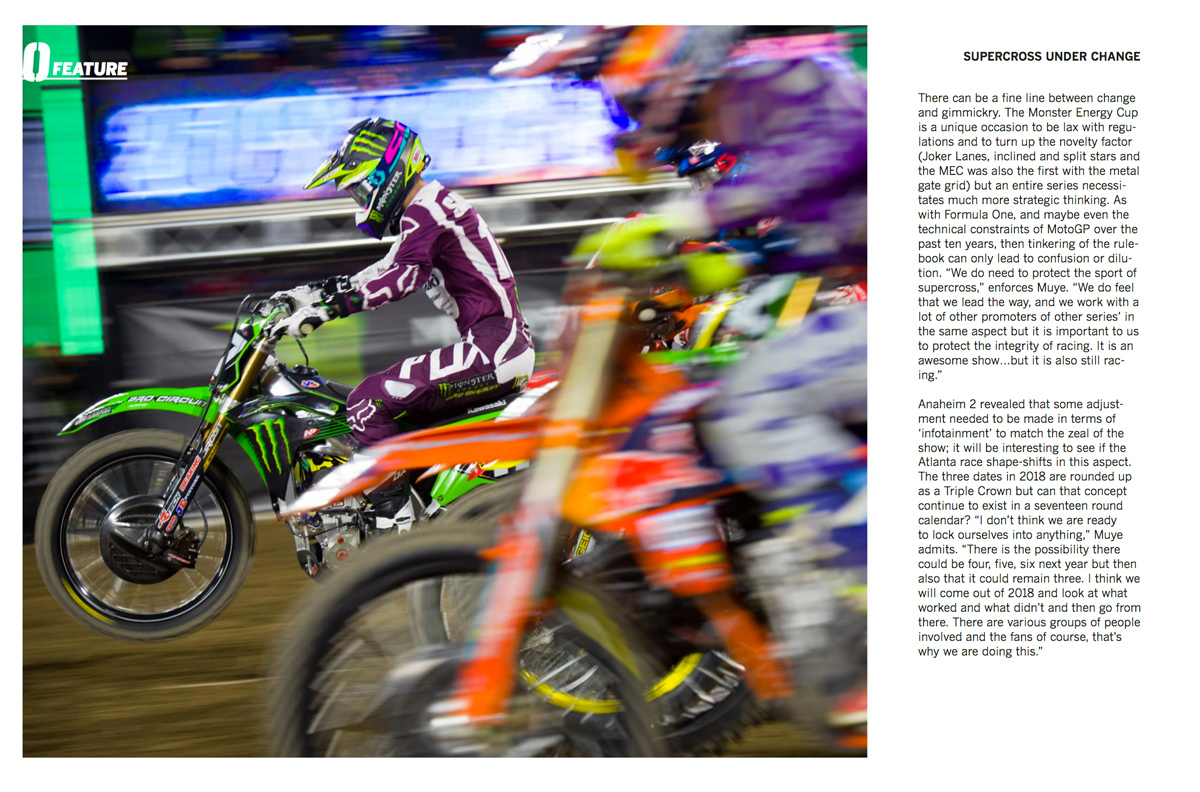Around Anaheim ‘2’ and the third round of seventeen of 2018 AMA Supercross there was a feeling of ‘all change’. The second Angel Stadium fixture of the year was the scene for the first ‘Triple Crown’ experiment in Supercross but there was also an openness to the 450SX category for the first time this decade, certainly since a young Ryan Dungey started his trawl of consistency and excellence on the bigger bike in 2010. At the time of writing Monster Energy Kawasaki’s Eli Tomac has capped the first ‘double’ of the season by winning in Glendale to match his success from ‘A2’. Yamaha’s Justin Barcia and HRC’s Ken Roczen claimed trophies once more at the University of Phoenix and their regularity (without walking the top step) thus far could be a factor in the ’18 championship pursuit.
Tomac should be one of the favourites. Despite his slip and shoulder tweak at A1 the 25 year old claimed nine wins in 2017, but at the same time showed the paradox of an intense series that is run-and-done in just nineteen weeks. His streak of victories last year proved that a deficit in the standings can be smashed…although his eventual defeat by just four points to Dungey illustrated that each and every position really does matter.
Whether Tomac can instigate a new era of superiority will be one of the principal questions as Supercross barrels to the halfway marker at Atlanta. Red Bull KTM Marvin Musquin’s fitness will be a key issue as well as Rockstar Husqvarna’s Jason Anderson’s potential: at Anaheim 2 the 24 year old’s corner speed and manoeuvrability on the Husky was one of the most eye-catching elements across the three Main Events.
Away from the entry list, how did the Triple Crown fare? We previously offered some opinion in our website Blog, and with some distance our observations remain the same: there needs to be more provision for the spectators/viewers to chart which riders are in the running for victory and podium spots. It was fantastic that the night programme (which involved a humorous multi-rider scripted video) led straight into bona fide gatedrops (no faffing with qualifying, heats or semis) but would perhaps work better with a two-race format. Fans could at least relate to the sight of two winners – WorldSBK style – if preoccupation with the overall points and positions was too much hassle.
The riders described a sense of ‘chaos’ and the opening sprint of just eight minutes meant a premium placed on starts with little time afforded to the fitter or more technical athletes to regain ground. The A2 track was fairly simplistic in terms of demand and this gave each ‘Main’ a processional feeling.
The Triple Crown will occur again at Atlanta and Minneapolis (rounds nine and fourteen, meaning East region 250SX get a double dose) and it’s to Feld’s credit that they are prepared to lift up and examine a lucrative product and also persuade key partners like the Fox Sports TV network to embrace change. If the three Main Event show remains or become more prevalent then it adds more validity to the Monster Energy Cup in October; a one-off invitational occasionally viewed as an obligatory burden for some teams after a long term of SX & MX but also as a viable testing opportunity and where the three-Main system has been in place since 2011.
“We got our feet with the Monster Cup,” says Mike Muye, Senior Director of Operations at Feld Motorsport. “The difference here at A2 is introducing the 250 class, so timing was the thing we played with the most for the format. I think we have a pretty good balance between the classes. The duration of the races helps out quite a bit. It meant working with the OEMs to make sure they were onboard and supportive. I think everybody agreed that we needed some change. It wasn’t just ‘something out of the box’; we talked with manufacturers and the race teams and came up with something that made sense for everybody.”
“We worked with Fox Sports 1 on implementation of this and we did have to change the show run-downs quite a bit to fit the pieces of the puzzle but at the end of the day it is still a three hour show and it is almost the same amount of racing; I think there is only a two minute difference,” he adds.

The attitude towards the Triple Crown was one of receptiveness, mixed with slight trepidation on the part of the riders themselves. “It’s a little stressful because it is something new…but it is kinda cool to see the sport evolving in a way and seeing if this new thing works,” HRC and Troy Lee Designs rider Cole Seely said to us. “If it does then it’ll stick around, if it doesn’t then it can be scrapped for next year. I think it re-ups the interest for the fans. We had the 20 minutes +1 change and that stuck around and now this, so we’ll see how it goes. It is just weird shifting everything an hour earlier for us!”
Elsewhere there was healthy curiosity in the paddock. For a definition of what supercross ‘is’, ‘was’ and ‘might be’ then there was only one figure to seek out. “I’ve been in this my whole life and when the gate is about to drop I’m still like a little kid; I’m still passionate about it,” enthused Jeremy McGrath. “I don’t feel that you need to be a motorcycle fan to enjoy this show. Competition is alive and well and on a selfish side I guess I’d like to see a bit more personality from these guys but sometimes competition breeds seriousness; know what I mean? This is a real sport, real job and these guys are athletes.”
“We live in a world where everything has to change, and change fast-and-now,” the Kawasaki ambassador added. “Everyone is bored after a minute. When we were young it was different and it seems that people’s attention span now is so short. It is always ‘what’s the next thing?’ and unfortunately sports get hit with that too. You know, I’m excited for the format change – I think it’s awesome. Do I think it needs a change? I’m not sure. I think Supercross on the whole is a tried-and-true formula that works…although it doesn’t hurt to mix it up a little bit.”
“They have been saying that motocross is a dying format for years but it keeps going,” he goes on. “I think motocross is something that people can relate to. That’s why Supercross is such a big show right? People come here to see and watch something they cannot do. This is a spectacle. Not everyone can ride a track like this or do these kinds of things.”
“Supercross is obviously the future of the sport, even though it has been around for years and years,” offers Seely. “It is more viewer-friendly. People can go out and do what they want to during the day – even ride – and then get ready for the night show. On the other side that’s what’s great about motocross: it is that true hardcore, grassroots of the sport and racing. It is good to have both even though it is tough as a racer. I think there is a good balance and it is interesting to be part of the sport now while it is going through these growing pains.”
Feld were keen to stress the collaborative nature of the Triple Crown. “Historically there hasn’t been much change and we have run the basics of this format since the mid 1970s but I think this is a new era,” says Muye. “We sat down and asked the OEMs what they were interested in as well as the riders and they can see the big picture; moving supercross to the next level involves change. I don’t see us changing every year but there will be more to come.”
“I think people can be wary of anything that’s new but we have had good feedback and that it’s something fresh,” he adds. “We just need to make sure that everything runs smoothly.”
There can be a fine line between change and gimmickry. The Monster Energy Cup is a unique occasion to be lax with regulations and to turn up the novelty factor (Joker Lanes, inclined and split stars and the MEC was also the first with the metal gate grid) but an entire series necessitates much more strategic thinking. As with Formula One, and maybe even the technical constraints of MotoGP over the past ten years, then tinkering of the rulebook can only lead to confusion or dilution. “We do need to protect the sport of supercross,” enforces Muye. “We do feel that we lead the way, and we work with a lot of other promoters of other series’ in the same aspect but it is important to us to protect the integrity of racing. It is an awesome show…but it is also still racing.”
Anaheim 2 revealed that some adjustment needed to be made in terms of ‘infotainment’ to match the zeal of the show; it will be interesting to see if the Atlanta race shape-shifts in this aspect. The three dates in 2018 are rounded up as a Triple Crown but can that concept continue to exist in a seventeen round calendar? “I don’t think we are ready to lock ourselves into anything,” Muye admits. “There is the possibility there could be four, five, six next year but then also that it could remain three. I think we will come out of 2018 and look at what worked and what didn’t and then go from there. There are various groups of people involved and the fans of course, that’s why we are doing this.”
“I think the field would struggle to make it through the whole season,” said Tomac when prompted if the three Main Event structure could expand and even encompass the full gamut. “When you add two extra starts and that much pressure to everyone on the line [then] there is quite a lot of risk involved. A whole season wouldn’t be a good thing.”
“It is too hectic for eighteen rounds of that!” backed-up Anderson. “One start a night with all the top guys is one thing but tonight doing three is pretty crazy; if you are not in the top two then you don’t know if you are going to hit the triple or double it.”
“It’s pretty scary even if it is more action for the fans…but it is more unforgiving,” concluded Seely.
“It is tough because consistency is key and it is just quick sprints,” said 250SX points leader Shane McElrath, who negotiated 6, 10 and 12 minute Mains. “I thought it was a good trial run for being in the middle of these first six rounds.”
An indication of where Supercross could go next probably exists on somebody’s laptop and could even be aired at a meeting with the teams and manufacturers at some point in the coming months. Whether it’s more flexibility with the races themselves, the points or an element of the show there is also another area where the sport and series could make a significant jump: outside the borders of North America. Taking AMA Supercross ‘international’ has been on or near the agenda for a number of years and the provision of a TV package online and a stronger social media offering from Feld and their staff has added more impetus. It would be a direction that requires hefty cost, co-production credits with an organisation overseas and a seemingly impossible scheduling in a calendar that barely has any elbowroom. However the notion survives and fluctuates in plausibility. “Supercross’ origins are here in America but our social numbers as well as television broadcast numbers prove to us that there is international interest,” affirms Muye. “Globally it’s very strong and it needs to grow. I cannot say we’ll be heading overseas right-away but there is a lot of growth potential elsewhere.”
For now Tomac, Anderson, Roczen and collective are one of the reasons why Supercross remains so engrossing and so magnetic in the same way that sheer speed and physics resonates so highly in MotoGP and WorldSBK. Whether it is one Main Event or three, ‘SX’ is arguably floating in an unpredictable and enjoyable phase and seeing where it can go next is almost like trying to call a 450SX overall winner each weekend.
Photos by James Lissimore








